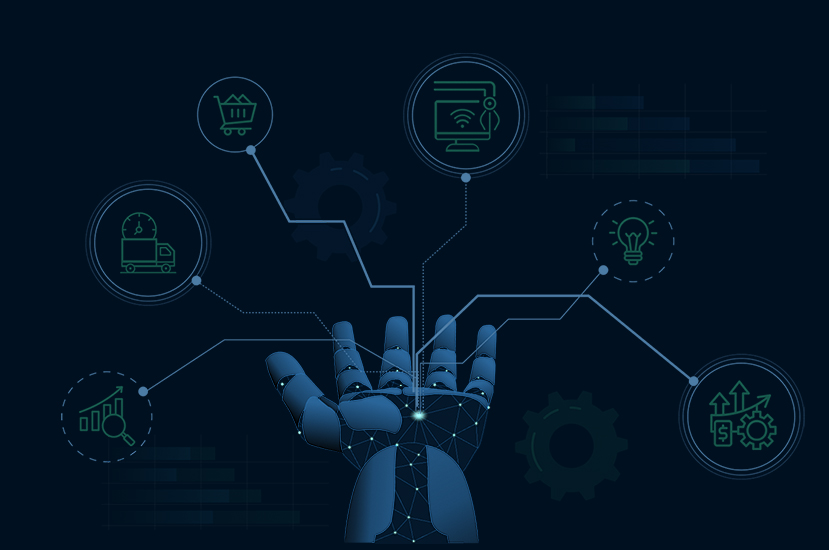The world we live in now is being gradually enveloped in technology. Some are the result of world events like Covid-19, some from successful startups, and some from the planned replacement of manual work with mechanical work. In any case, all this improves our life, making them easier and more accessible. We spend less of our time and resources, and we have the opportunity to channel them into creativity, while automated systems do the slow, uninteresting work for us.
AI and ML in e-commerce and retail produce the application of large-scale technologies and, as a result, huge opportunities for development.
What are ML and AI for E-commerce and Retail?
E-commerce is retail trade – industries that very often depend on external factors. Changes in trends, economic conditions, moods, or even a pandemic – all depend on the trends of industries. So, according to the publication Statista, in 2021, the amount of 5 trillion dollars was successfully exceeded and the e-commerce industry accounted for 3% of the total share of retail trade.

Business owners gather a considerable number of technologies to improve their services, establish communication with the client and provide comfortable service. Therefore, ML and AI are the keys to implementing all potential ideas.
That is why it is predicted that by 2025 AI will fill all e-commerce stores by 95% and sales with it will reach the mark of 7.3 trillion US dollars.
According to a study by Meticulous Research, the implementation of Artificial Intelligence I in the retail market will rise by 34.4% and will reach $19.9 billion by 2027.

The use of Machine Learning and Artificial Intelligent technology is beneficial primarily because of their ability to analyze large volumes of data, such as customer demographics and purchase history. This made it possible to generate a prediction of a potential purchase and a recommendation to the customer.
The adaptation of machine learning and artificial intelligence has already been touched on:
Cashless stores, chatbots for service, price editing, price forecasting, logistics and delivery, visual and voice search, and predicting customer behavior – and this is not the whole list of improvements that will soon appear both in the field in general and in individual stores.
What to Expect from Machine Learning and Artificial Intelligence in 2022?
How ML and AI are Impacting the E-Commerce and Retail Industry in General
It is certainly possible to accurately predict that the use of AI and ML will become even more popular. Many retail and e-commerce companies are already incorporating technology into their development processes. Let’s take a look at the predictions for 2022:
- Analytics of user behavior
- Image recognition
- Inventory management
- Automation
- Virtual dressing rooms
- AI-driven mood detection
- Augmented and Virtual Reality
- The Emergence of Headless E-commerce
- Drone delivery
It is worth taking a closer look at how AI and ML technologies can improve the trading market
Drone Delivery
Let’s start with the most interesting – drone delivery. How possible is this? It is clear that not all sellers will need such a function. Nevertheless, those who will use it will have great advantages over competitors. It will be beneficial, first of all, to companies that cover a large consumer base in different areas, which will be able to hire an expert in drone maintenance and is engaged in the supply of light products. And while this technology is still in its infancy, such innovation will bring attention to e-commerce and increase customer satisfaction.
Virtual Reality
The 3D format produced by virtual reality allows the customer to view products from all sides. In addition, it makes it convenient to project how the product will look in a real environment. This will increase the rationality of purchases and, accordingly, customer satisfaction. One such example is Marxent, which develops a 3D platform used by both retailers and consumers. Solutions provided by Marxent allow you to visualize furniture or household goods in your space. Among the company’s clients are many of the closest retailers from around the world.
AI-driven mood detection
The introduction of technological solutions of service robots allows closer interaction with the client, recognizing speech, gestures, or intonation. Robots become guides for people, minimizing their contact with other people or objects. Thus, systems can recognize a person’s speech, mood, and changes in their voice. Such development of the emotional intelligence of systems makes it possible to establish cognitive and emotional channels of communication with the client.
Fitting
Machine Learning and Artificial Intelligence methods create the possibility of virtual fitting. Currently, such an initiative already exists for the virtual fitting of jewelry, sneakers, or jewelry. Old Navy, Levis, Brooks Brother, and Gap increased their revenue by 33% thanks to the implementation of this technology. IKEA, for example, allows its customers to see how certain furniture will look in their apartments. To do this, they just need to direct the camera to the place where the purchase will be located, and Artificial Intelligence will calculate whether everything will fit correctly.
Many of the processes will be automated, and much improved, delivery management, voice recognition, Face Recognition, Visual Inspection, Retail Personalization, and price management will be improved. In conclusion, it will become more comfortable for people to shop without spending extra time and resources on it.
In Final Words
AI and ML continue to develop without losing their pace. They enable stores and services to grow by providing them with revolutionary solutions to improve their business. Artificial Intelligence offers a flexible and high-quality development strategy for companies, thanks to which they can better understand their customers, maintain contact with them and find an individual approach. In consequence, you will increase your income and gain leadership among competitors.
Learn more about the potential of Machine Learning and Artificial Intelligence by reading our articles.





